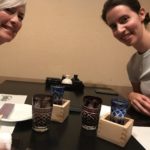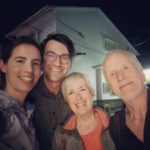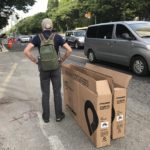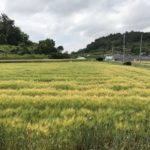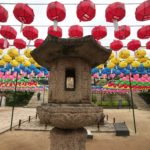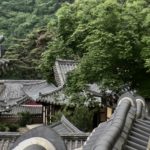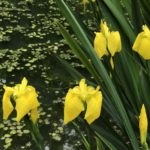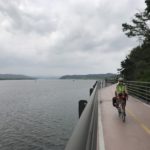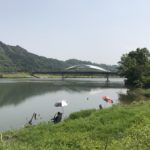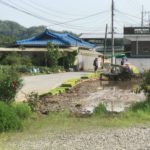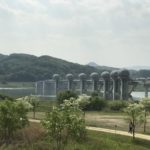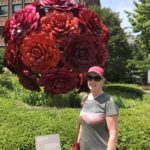Busan to Fukuoka
One of the lessons we have learned in cycle touring is that “it’s never over until it’s over!” Often, this means that just when you think you’re getting near the end of a ride and beginning to anticipate that glass of wine or warm/cool shower, another hill suddenly materializes! In this instance, it was in getting ourselves and our bikes from Korea to Japan.
It started well. Our extraordinarily helpful hotel (Best Louis Hamilton) arranged a van taxi to take us to the International Cruise Ship Terminal, where we were booked on the fast (3-hour) walk-on ferry to Fukuoka. The first challenge was in getting to the departure level, one floor up from our drop-off point.The elevator we were waiting by kept arriving full, with many young mothers and babies in strollers coming up from the parking lot heading to a baby exhibition on the top floor. Luckily, we were eventually rescued by a guard who directed us to another less-used elevator. As we joined the queue of people checking in with Beetle ferries, we noticed the staff directing concerned looks at our two bike boxes perched on a trolley. They rushed over to ask what we were carrying and promptly told us we could not take our bikes on the ferry and that we should take another boat! When we protested that our hotel had checked with the company and that, at any rate, there was no other boat going to Fukuoka, they inspected and measured the boxes and asked us to wait, presumably to see how full the boat would be. 1/2 hour later, we were told that we could not board as the boxes were too big. We asked whether we could bring our bikes if they were in bags, but the answer was still no. The bikes were too big!
Plan B was to look at the later overnight ship to Shimonoseki, between Fukuoka and Hiroshima. This would mean bypassing Fukuoka, which we were a bit reluctant to do as we were meeting friends from Vancouver. Lois returned to report that our challenges were increasing – she was told that we could bring our bikes on their ferry but could only “ import” the bikes into Japan if we had a plane ticket to leave the country again! We did not think that this was either correct or feasible.
We decided to try plan C. Paul called Korean Air to book a flight leaving at 5:55 pm. It was now 3:00 and the airport was a 30 minute cab drive away. It was after 3:30 by the time the reservation was completed and neither of us was very calm at this point! Then we had to get back downstairs and try to find a taxi big enough to transport us and the bike boxes to the airport. Unusually, the waiting cab drivers were indifferent and seemed to be amused at our plight. When we suggested that we might take two cabs, this did not seem possible. A call to the Best Louis Hamilton Hotel (they will get an excellent Trip Advisor review!) was in order. 45 minutes later, a van arrived to pick us up.
We arrived at Busan International airport just before 5. We could have kissed the Korean Airlines official, who assured us that we could check our bikes. She also suggested that we could avoid some excess baggage costs by taking Lois’ panniers on as hand luggage and strapping Paul’s larger panniers together to make one checked bag. When we asked whether there were plastic bags to better protect our bikes, she directed us to a baggage packing service one floor up. The three young people at the packing service could not have been more helpful, cheerful and efficient. 30 minutes and a lot of bubble wrap later, we were on our way again downstairs to drop off the boxes and panniers. As we were heading towards the departure gates, we were called into a room where our bike boxes were being x-rayed. They had discovered that Paul had inadvertently left a small compressed air canister in with the bike tools! That was sorted out and the boxes were taped up again. Time was marching on, but luckily the flight was delayed by 15 minutes. So, on through security where a small wrench and Allen key longer than the 10 cm limit (just), were found in Paul’s bar bag! We really did need these tools to reassemble the bikes and said so. It was now 5:45! To our surprise, the security officials called a representative of Korean Airlines who came and inspected the offending articles, removed them and took them away. We were told we would get them back on deplaning! We were shown the envelope and given another baggage claim ticket as we boarded the plane, just in time!
The short flight and immigration in Fukuoka was smooth. While we were waiting for our checked bags, two attendants appeared pushing our bike bags on a trolley together with the envelope with the two tools – service indeed! The Japanese customs agents did search one of Paul’s bags and we had to wait for the bikes to be x-rayed again and then we were thanked for our cooperation and we were in Japan! Once outside, we were able to hire two taxis, one for us and one for the bikes, with no problem. At our hotel we were just going up to our (very tiny) room with bikes and panniers in tow when the receptionist came running after us to say we were bring upgraded to a larger room!
After all this, it was a relief and pleasure to be able to meet Rory and Sofia for a walk through downtown and dinner at a charming Nepalese establishment in
Tenjin.


























